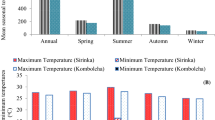Abstract
The water requirement of the crop is an important phenomenon to estimate the crop yield and understanding the crop water necessity at different crop phenological stages as soil and plant water deficits cause yield reduction. The most crucial crop stages that dictate crop yield are at the vegetative and reproductive stages, reducing the crop yield by more than 35% and 50%, respectively. Our study is to determine the crop water stress using the Crop Environmental Resource Synthesis (CERES)-Sorghum model, which is a component of the Decision Support System for Agrotechnology Transfer (DSSAT)—crop simulation model (CSM). Crop water stress is simulated spatially for Rainfed Kharif Sorghum (Sorghum bicolor (L.) Moench) in 10 districts of Maharashtra state, India, from 2000 to 2018 using DSSAT-CSM. Besides other factors as well that impact crop yield, rainfall also has an impact on crop growth, development, and managing water efficiency for the crops. Simulated crop water stress above a specific threshold value of ≥ 0.5 (50%) impacts crop growth and development process. Considering the drought year 2015 with sowing dates June (15, 22, 29) and July (6, 15); it shows that late sowing of kharif sorghum for 2015 minimal crop water stress can be seen. CERES-Sorghum model can efficiently determine the crop water stress at different crop phenological stages with different dates of sowing.











Similar content being viewed by others
References
Ahammed SJ, Homsi R, Khan N et al (2020) Assessment of changing pattern of crop water stress in Bangladesh. Environ Dev Sustain 22:4619–4637. https://doi.org/10.1007/s10668-019-00400-w
Camargo G, Kemanian A (2016) Six crop models differ in their simulation of water uptake. Agr. Forest Meteorol. 220:116–129. https://doi.org/10.1016/j.agrformet.2016.01.013
Dhakar R et al (2018) Field crop response to water deficit stress: assessment through crop models. In: Bal S, Mukherjee J, Choudhury B, Dhawan A (eds) Advances in crop environment interaction. Springer, Singapore. https://doi.org/10.1007/978-981-13-1861-0_11
Gohain GB, Singh KK, Singh RS, Singh P (2020) Regional Crop Yield Estimation System (RCYES) using a crop simulation model DSSAT V4.7: concept, methods, development, and validation. J Agrometeorol 22(22):33–38
Hoogenboom G, Porter CH, Shelia V, Boote KJ, Singh U, White JW et al (2017) Decision Support System for Agrotechnology Transfer (DSSAT) Version 4.7 (https://DSSAT.net). DSSATFoundation, Gainesville, Florida
Hoogenboom G, Porter CH, Shelia V, Boote KJ et al (2019) Decision Support System for Agrotechnology Transfer (DSSAT) Version 4.7.5 (https://DSSAT.net). DSSAT Foundation, Gainesville, Florida, USA
Huda AK, Sivakumar MV, Rama YS, Sekaran JG, Virmani SM (1987) Observed and simulated responses of two sorghum cultivars to different water regimes. Field Crops Res 16(4):323–335. https://doi.org/10.1016/0378-4290(87)90070-0
Jones JW, Hoogenboom G, Porter CH, Boote KJ, Batchelor WD, Hunt LA, Wilkens PW, Singh U, Gijsman AJ, Ritchie JT (2003) DSSAT Cropping System Model. Eur J Agron 18:235–265
Keating BA, Carberry PS, Hammer GL, Probert ME, Robertson MJ, Holzworth D, Huth NI, Hargreaves JN, Meinke H, Hochman Z et al (2003) An overview of apsim, a model designed for farming systems simulation. Eur J Agron 18(3–4):267–288
Khaliq T, Ahmad A, Hussain A, Hoogenboom G (2007). Modeling Nitrogen Use Efficiency of Maize Cropping Systems in Pakistan. In Proceedings of the International Annual Meeting of ASA-CSSA-SSSA (pp. 4–8). New Orleans, Louisiana
Kumar SR, Hammer GL, Broad I, Harland P, McLean G (2009) Modelling environmental effects on phenology and canopy development of diverse sorghum genotypes. Field Crops Res 111(1–2):157–165. https://doi.org/10.1016/j.fcr.2008.11.010
Negm LM, Youssef MA, Skaggs RW, Chescheir GM, Jones J (2014) DRAINMOD-DSSAT model for simulating hydrology, soil carbon, and nitrogen dynamics, and crop growth for drained agricultural land. Agric Water Manag 137:30–45. https://doi.org/10.1016/j.agwat.2014.02.001
Pai DS, Sridhar L, Rajeevan M, Sreejith OP, Satbhai NS, Mukhopadhyay B (2014) Development of a new high spatial resolution (0.25× 0.25) long period (1901–2010) daily gridded rainfall data set over India and its comparison with existing data sets over the region. Mausam 65(1):1–8
Ritchie JT, Singh U, Godwin DC, Bowen WT (1998) Cereal growth, development, and yield. Understanding options for agricultural production. Kluwer Academic Publ, Dordrecht, pp 79–98
Singh KK, Baxla AK, Chattopadhyay N, Balasubramanian R, Singh PK et al (2017) Crop Yield forecasting under FASAL. FASAL Technical Report-2017. India Meteorological Department, New Delhi, 155p
Srivastava AK, Rajeevan M, Kshirsagar SR (2009) Development of a high resolution daily gridded temperature data set (1969–2005) for the Indian region. Atmosph Sci Lett. https://doi.org/10.1002/asl.232
Van Diepen CV, Wolf J, van Keulen H, Rappoldt C (1989) WOFOST: a simulation model of crop production. Soil Use Manag 5(1):16–24
Virnodkar SS, Pachghare VK, Patil VC et al (2020) Remote sensing and machine learning for crop water stress determination in various crops: a critical review. Precision Agric 21:1121–1155. https://doi.org/10.1007/s11119-020-09711-9
Author information
Authors and Affiliations
Corresponding author
Additional information
Publisher's Note
Springer Nature remains neutral with regard to jurisdictional claims in published maps and institutional affiliations.
Rights and permissions
About this article
Cite this article
Gohain, G.B., Singh, K.K., Singh, R.S. et al. Application of CERES-sorghum crop simulation model DSSAT v4.7 for determining crop water stress in crop phenological stages. Model. Earth Syst. Environ. 8, 1963–1975 (2022). https://doi.org/10.1007/s40808-021-01194-5
Received:
Accepted:
Published:
Issue Date:
DOI: https://doi.org/10.1007/s40808-021-01194-5




